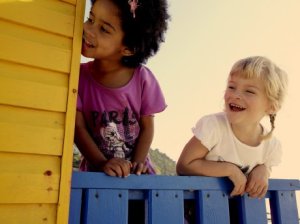An Example of PBL in Early Elementary: How I Started

I am a first grade teacher who has taught for twenty years. When I look at my students and see how much the first grade classroom has changed over time, it is hard for me to imagine what jobs will be out there for them in 15 years. However, what is clear is that there are specific skills -- both academic and interpersonal -- that my students will need to possess to find a successful career. The Common Core standards clearly outline what my students need to be able to master when they leave first grade, however there are also other crucial skills that many educators are calling the 4 C’s: Collaboration, Communication, Critical Thinking and Creativity that are skills highly desired by future employers.
As a teacher I have asked myself, "How do I integrate the Common Core Standards and start teaching these other highly desirable skills in first grade?" My answer to this question has been found in Project Based Learning (PBL).
My biggest challenge has been where to start. I purchased PBL in the Elementary Grades, and I decided to start small. I started the year with the usual review of the alphabet. But this year, all of the letters coincided with local animals. Letter F was the Yellow Legged Frog. Students found out that this local frog has become a "species of concern". Students wanted to help save this little creature and so our first project for the year was: How can we help save the Yellow Legged Frog? The link below shows how beginning first graders were able to help save our local Yellow Legged Frog.
During the second half of the year, my students became involved in the Trout in the Classroom project. Our three first grade classes have been a part of this project for several years. We have gathered activities, made PowerPoint presentations, and found books that we have used for several years to teach this unit. However, I wanted to turn this unit into a PBL experience. I felt relatively successful with my first attempt at PBL with the Yellow Legged Frog Project but decided I really needed to review the Common Core science and writing standards so that I could address as many standards as possible during this project. I also wanted to give my students a meaningful purpose to what they were learning. Thus, the most important things I considered when I started to convert our fantastic unit into a PBL experience, were:
1. The Driving Question
The driving question for this year’s Trout in the Classroom project became: “How do we teach others to successfully raise trout eggs and help them understand the importance of keeping our watersheds healthy?” This driving question gave true purpose to what students were learning throughout this project.
2. The Common Core standards that can be incorporated throughout the unit
In the movie link below, you can hear which standards were addressed throughout this unit.
3. The local agencies or experts that could lend experience or insight into my students’ understanding of the subject matter
For this project, we partnered with Trout Unlimited, California Fish and Game Department, Marin Municipal Water District, and the Watershed Stewards Program.
4. The audience outside of our immediate classroom community
Our audience became a classroom in San Francisco where a friend of mine teaches kindergarten.
I can see how PBL is the vehicle by which I can teach both the Common Core Standards and the 21st century competencies to my first graders. I am also very excited that I don’t have to throw out all the great units I have taught in the past, but instead can view them through a PBL lens. This requires just those four things outlined above to get started. In the future, I am looking forward to using just those four basic ideas to help my kindergarten teacher friend turn her oviparous animals unit into a Project Based Learning experience!